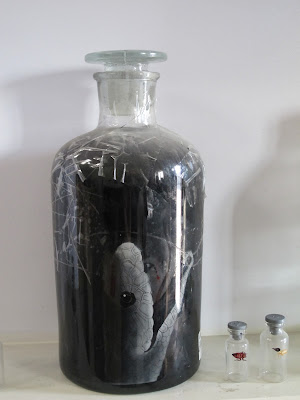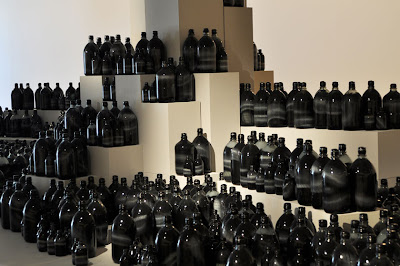 |
| Chang'An Avenue, image courtesy the artist, China Art Projects, installation view at Ten Cubed Gallery, Melbourne |
“My work is like a scientific laboratory”
The installation practice of Liu Zhuoquan
 |
| Liu Zhuoquan in his studio, photograph Luise Guest reproduced with permission of the artist and China Art Projects |
Liu
Zhuoquan was born in Wuhan, Hubei Province, China, and spent a number of years
living and working in Tibet.He currently
lives and works in Beijing.
Artist's Practice
Liu Zhuoquan works with traditional craftsmen
who have mastered the ancient art of 'inside painting', or ‘neihua’ once used on the beautiful snuff
bottles dating from the Ming and Qing dynasties. In Liu Zhuoquan's practice,
however, they become ways of making a comment on many aspects of life in China
today. The bottles, which in Liu’s practice are found objects, used bottles
which have held a range of products, in varying sizes and shapes, are
delicately and precisely painted on the insides. Precise technique and the use
of fine brushes create immensely detailed and realistic representations of
people, the natural world of plants and insects, as well as political imagery
from the Cultural Revolution and contemporary events in China and the wider
world. Barack Obama features on one bottle.
Liu sees his work as suggesting a scientific laboratory, as the bottles
(discarded and 'found' objects referencing the everyday) contain beautifully
painted, miniaturised 'experimental material' relating to nature, biology,
human society and also to politics. Liu Zhuoquan, although born in Wuhan, spent
many years in Tibet, and the beliefs and practices of Tibetan Buddhism have
profoundly affected his world view and his own art practice. The artist is
assisted in the creation of these works by artisans trained in traditional
techniques - in this way his practice may be connected with other contemporary
artists both in China and internationally, such as Ah Xian, Antony Gormley,
Patricia Piccinini and Janet Laurence. They also comment on our mania for
classifying and thereby containing the world and everything in it – a wry
Buddhist comment on the impossibility of controlling our world. (Luise Guest)
 |
| Liu Zhuoquan, insect bottles, image reproduced courtesy of the artist and China Art Projects |
The Artist and His World
Some
of the bottles reference the present, and the dramatic changes people must
accommodate in their daily lives as China embraces the global economy. For
example, some have expensive branded sneakers painted in them, whilst others
reference more controversial subject matter. He sometimes enters territory that is a subtle and carefully encoded critique of aspects of modern China, with works referencing such issues as the death penalty and the way in which executions are carried out; the 'harvesting' of organs for transplant from prisoners; the damage to the environment from rapid industrialisation; and issues of censorship. Others contain lovingly painted
landscapes, plants, fish, birds and insects. They are not obviously political,
rather they refer to Buddhism and to the world view that Liu Zhuoquan found in
his years spent in Tibet, where the natural, spiritual and material worlds are
connected. It is in the juxtapositions of multiple bottles – the proposed
installation of 10,000 of these delicately painted microcosms – that multiple
meanings and interesting counterpoints can be formed and found.
 |
| Liu Zhuoquan 'Snake' bottle, image courtesy of the artist and China Art Projects |
Look at the artworks and answer the questions below:
Structural Frame
Outline the techniques used by Liu Zhuoquan
to create these works, both individually and in the form of site-specific
installations
Subjective Frame
Imagine the response of the audience to an
installation of 10,000 of these painted bottles, surrounding them on all sides
– how might the audience respond?
Cultural Frame
Compare the work with a traditional Chinese
landscape painting from the Song dynasty – find similarities and differences between
the two.
The works below, '3 Black Fish' and '4 Red Fish' are typical of his practice.
What makes his work different from traditional Chinese paintings?
What makes his work different from traditional Chinese paintings?
 |
| 3 Black Fish, image courtesy of the artist and China Art Projects |
 |
| 4 Red Fish, image courtesy of the artist and China Art Projects |
Read the extracts of art critical writing about Liu Zhuoquan and respond to the questions.
Critical Analysis #1 Liu Zhuoquan – scenes inside the bottle
The production of museum-scale installations may at first glance seem incompatible with the work of Liu Zhuoquan, an artist whose practice centres on the well-known craft of snuff bottle painting. Popular items in the tourist trade, these pocket-sized vessels are painted charmingly from within; a disarming technique perfected by Chinese artisans with nothing but long-haired brushes and patiently practised skill. Liu Zhuoquan takes the production of these items to an epic and prodigious level, amassing them row upon row in concert with other similar items. Acquisition of these bottles is customarily a thing of individual selection, a memento of personal choice. Bringing so many together however, they register not as things precious and rare but rather as products of mass production – the efforts of nimble, anonymous hands who scrabble in the markets of labour. What, one wonders, are the conditions under which items of this nature are produced? …In place of touristy vignettes, medical diagrams of dissected organs and limbs are displayed gruesomely therein. Reminding one of the disparities between the citizens of developed nations, and those in the sweatshops of the world, the likes of which remain the basis of our global economy, what the bottles contain is not some artistic endeavour but the life, limbs and essence of the worker who toils for the amusement of others. With the passing of the Cultural Revolution, crafts of this nature, once forbidden as decadent things of the past, steadily returned to China’s bustling markets. Somewhat surprisingly Marxist and Maoist ideology appears to haunt these delicate works. Created in the latest era of Chinese prosperity they contain not only images but the essence and echoes of toil.
Damian Smith, Beijing 2010 (China Art Projects Catalogue for Melbourne Art Fair 2010)
Damian Smith, Beijing 2010 (China Art Projects Catalogue for Melbourne Art Fair 2010)
Using the conceptual framework (artist - audience - world relationships) answer these questions:
- Explore some of the ways in which Liu Zhuoquan is responding to aspects of his own contemporary Chinese world, and creating a range of possible meanings for audiences
- What are his artistic intentions in working in this manner?
- How do his works connect to cultural and personal ideas and beliefs?
- The artist is assisted in the creation of these works by artisans trained in traditional techniques - how is this a practice which connects him with the contemporary artworld? Can you find some other examples of artists who do not physically make all of their own artworks? (Hint: Look up Patricia Piccinini, Jeff Koons and Damien Hirst!)
 |
| Liu Zhuoquan with new 'streetlamp' works in his Beijing studio, photograph Luise Guest 2012 reproduced with permission of the artist and China Art Projects |
 |
| Liu Zhuoquan, body part bottle series, photograph Luise Guest reproduced courtesy of the artist and China Art Projects |
 |
| Explosion Proof Lamp, 2012, image reproduced courtesy of the artist and China Art Projects |
 |
| Explosion Proof Lamp, image reproduced courtesy of the artist and China Art Projects |
Read Critical Analysis Extracts #2 and #3 about Liu Zhuoquan and respond to the questions.
Critical Analysis #2 Liu Zhuoquan in the White Rabbit Gallery
He began collecting discarded bottles of all
shapes and sizes, from perfume bottles to Coke bottles. Painting on their
insides with fine, bent-handled brushes and dilute mineral colours, he
“inserted” plants, animals, monsters, mountains, weapons, furniture. Influenced
by eight years in Tibet, where he embraced Buddhist spirituality, he set out to
compile a library of 10,000 things. The bottles in his Object Series (2007) look
like scientific specimen jars. Placing one or two items in each bottle isolates
them but also allows them to be freely combined. For Liu Zhuoquan the bottles
are like words; together they “describe the world”. Their glass
containers—visible or invisible “depending whether you look at the bottle
itself or the painting”—give them an aura of mystery.
 |
Liu Zhuoquan, Display
Box of 24 assorted glass bottles, 2010,
image reproduced
courtesy of the artist and China Art Projects
|
Critical Analysis #3 ‘Thousands of Worlds: Liu Zhuoquan and the Archeology of Objects’ by Huang Du
(this piece has been translated from the Chinese)
"He collects various peculiar bottles which have been consumed, and then
paints the insides of bottles using the chosen topics. This becomes the
highlight of inner bottle painting. This is an art form which evolves from
traditional Chinese folk snuff bottle inner painting. What differs from the
traditional art is that Liu Zhuoquan’s art focuses on integrating each independent
inner bottle painting into a unified art concept which is similar to a drug
store or a storage room instead of the painting skills of snuff bottle inner
painting. He rearranges the daily objects which are intensive yet organized,
and connects these objects with the bottles which still have the original brand
labels on: bottle with residue, bottle painted with broken fingers, bottles
painted with plants, organs, weed, insects, fish, bricks and other countless
objects. This is a brand new world created by artist. It is an image world just
like an encyclopedia and also an exhibition of bottles. Although this art piece
is of hybridity visually, the overall visual image conveys obscure dualism in
philosophy, which is unity of opposites between experience and
transcendentalism, normal and abnormal, violence and gentle, poetic and plain,
warm and cold, abstract and realistic, expressive and reserved…
…He raises questions using art – in nowadays society, are people
consuming materials or consuming symbols?"
The writer of Critical Analysis #3, Huang Du, suggests that the artist’s intention is not about the skilful
application of technique, nor about beautiful representations.
- What does the writer suggest the artist’s creative purpose is?
- Why does Liu Zhuoquan work with discarded, used bottles instead of new ones?
- How do his works suggest ‘dualism’ or binary opposites?
- What ‘questions’ are raised by Liu Zhuoquan’s artworks?
 |
| Liu Zhuoquan, Medicine Cabinet, image courtesy of the artist and China Art Projects |
 |
| Liu Zhuoquan, Broken Finger, 2010, Image courtesy of the artist and China Art Projects |
This particular work references the injuries (specifically lost fingers) in Chinese factories, where workers often have no choice but to work in unsafe conditions.
Now click on this link to find a catalogue essay about Liu Zhuoquan's 2013 installation 'Chang'An Avenue' http://www.chinaartprojects.com/liu-zhuoquan-essay/
Now click on this link to find a catalogue essay about Liu Zhuoquan's 2013 installation 'Chang'An Avenue' http://www.chinaartprojects.com/liu-zhuoquan-essay/
Having read all of the information and looked closely at the artworks, answer these questions
- What do you think are the most significant aspects of Liu Zhuoquan’s material practice?
- He says his work is like ‘a scientific laboratory’ – what do you think he means by this?
- How does Liu Zhuoquan reference traditional Chinese art in his work?
- Compare and contrast the practice of Liu Zhuoquan with Australian artist Fiona Hall OR with British artist Damien Hirst. In particular, look at Hall's work ‘Mourning Chorus’ or Hirst's 'The Impossibility of Death in the Mind of Someone Living' and comment on the way that each artist has employed ‘found’ and discarded materials to make a comment about their world.
 |
| Liu Zhuoquan, 'Where are You?' installation of glass bottles at the 18th Biennale of Sydney |


No comments:
Post a Comment